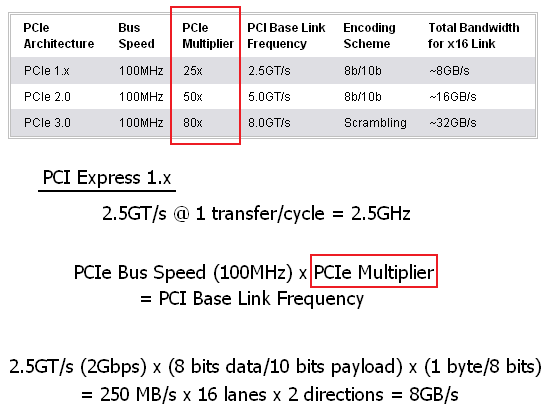It appears that per the article (if I understood this correctly) they found a discrepancy between the core clock speed reported by the driver and the core clock speed read from the clock generator directly. When you increase PCIe frequency instead of getting more bandwidth you over clock the video card. Nvidia's mobile GPUs are suppose to do this as well. Others have tied this in with not just manual PCIe frequency over clocking but the use of Link Boost as well. What some are saying (in other forums) is that:
-PCIe Frequency is not intended as a means to over clock the video card
-high PCIe frequencies can lead to HDD failure and other instability problems on some motherboards
-the average reviewer/ user wouldn't know the actual GPU clock of the video card
-if the PCIe Frequency is higher then 100MHz the video card was benchmarked at a higher OC then other competing video cards
-Shader clock is not effected
-Other comparison video cards do not have this feature when benchmarked.
-We really don't know if reviewers are increasing the PCIe Freq. when conducting benchmark reviews. Assumptions can be made but there is no proof that they don't increase PCIe Freq.
The article can be read here:
Source
There are a few other forums discussing it but I didn't see it mentioned in this forum. There are mix reactions to this news some love the idea while others question it's use. What are your thoughts?
-PCIe Frequency is not intended as a means to over clock the video card
-high PCIe frequencies can lead to HDD failure and other instability problems on some motherboards
-the average reviewer/ user wouldn't know the actual GPU clock of the video card
-if the PCIe Frequency is higher then 100MHz the video card was benchmarked at a higher OC then other competing video cards
-Shader clock is not effected
-Other comparison video cards do not have this feature when benchmarked.
-We really don't know if reviewers are increasing the PCIe Freq. when conducting benchmark reviews. Assumptions can be made but there is no proof that they don't increase PCIe Freq.
The article can be read here:
Source
There are a few other forums discussing it but I didn't see it mentioned in this forum. There are mix reactions to this news some love the idea while others question it's use. What are your thoughts?
Last edited by a moderator:

